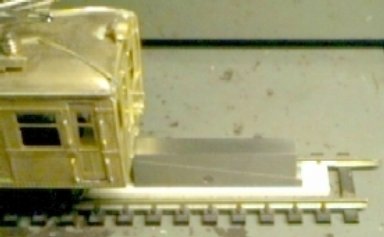After trying all sorts of contraptions, a machinist friend, Bob Shin, suggested machinists adjustable PARALLELS . These consist of two precision ground, rectangular , inclined plane bars, joined together by a sliding dovetail, with a locking screw. Sold in a set of four the largest has a useful measuring maximum of about 1.5". The range of the smallest is .365 - .563" or approximately 23/64 - 9/16", which covers most coupler cases.
In lieu of a highly desired surface plate with flange-ways, I settled for an 18" length of track with an Evergreen styrene strip glued between the tie plates. This is carefully leveled with the rail top.

Note: Adjust brightness and contrast for optimum viewing.
Measuring floor height with parallel on styrene strip.
The top of the parallel is raised above floor height then it is placed on the styrene. While holding lower piece still, car is pushed against extended top face, moving the top piece downhill. As soon as floor clears the edge, top piece movement stops. The lock screw is tightened, setting the height for future use. If value is needed, it is measured with calipers. This is very useful in adjusting coupler pad shims and selecting knuckle offsets.
The locked parallel can be used later to adjust floor height, during repowering or other modifications.
Less precise alternatives are to use a MODIFIED KADEE COUPLER HEIGHT GAUGE or a DEPTH GAUGE, if it fits.
BACK TO PARALLELS
BACK TO MEASURING ROLLING STOCK HIGHTS
BACK TO RDC TO SPUD
BACK TO IMP SUBWAY__METAL
BACK TO IMP SUBWAY__WOOD
BACK TO ALCO MU
BACK TO WALTHERS
